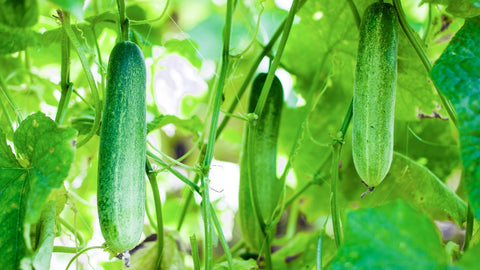In addition to light and care, vegetables need plenty of space, nutrients, and water. In order to give the plant the right supply of these things, using a well-designed planter makes all the difference. In this blog, we’ll review different vegetable needs, recommend a simple but effective setup, and explain how to give your plants the right amount of water and nutrients at the right time.
What’s the best planter for vegetables?
Vegetables thrive on consistent access to water and nutrients, but they’re also a bit particular about getting just the right amount at the right time. If they are too wet, some develop root diseases (cucumbers, peas, beans) or won’t ripen properly (tomato, pepper). Regarding nutrients, they all start off with similar needs, but as they use up certain nutrients, they need to be replenished differently. For their consistency and control alone, we recommend a Ceramic Self-Watering Planter (we also love how they’re easy to set up and simple to maintain) and following a plant-specific feeding schedule.

Testing out the main passive watering systems with our “sweet heat” pepper.
Free Draining Pots vs. Self-Watering Planters vs. Hydroponics
Using a pot and soil is attractive as it’s very simple and inexpensive. However, we find that the daily check-ups and precise watering that a simple pot needs to successfully grow vegetables can be challenging. Hydroponics work for some vegetables (like peppers and tomatoes) but aren’t great for Early-Harvest crops (cucumbers, peas, beans) that are prone to root disease or root crops (radish, ginger, garlic) that prefer soil to grow in. Self-watering planters combine a soil pot with some type of automatic water delivery. The most common use a wick, but these tend to result in soggy soil. Therefore, we prefer ones that use a semi-permeable ceramic wall, as they give precise control of the soil moisture and work excellently for all vegetables as well as other indoor edible plants.
How to grow vegetables with a self-watering planter
The instructions below are most relevant to our upcoming Self-Watering Planter (to be released summer 2021) but will work for most ceramic self-watering planters. There are a couple of current options on the market, including Wet Pots, COSWIP, and the Great Northern.
At the start, you want to encourage good root and leafy growth, and the best way to do this is to keep the soil moist, but not soggy. Start by filling the reservoir with water, then just let it run until empty. For all but tomatoes and peppers, this is the best watering regimen.

In order to concentrate sugars and develop flavorful tomatoes and peppers, it’s actually beneficial to put the plant under a little bit of stress. Once the little green veggies form, only fill the reservoir halfway—this will keep the soil a bit drier.

What’s the best soil for vegetables?
When they’re starting out, vegetable plants need a decent amount of nutrients to first grow big and bushy. A standard garden potting mix with an initial charge of slow-release “High-N” fertilizer will be all they need to get to the point they start producing vegetables. We recommend using this potting mix with additional slow-release fertilizer.
What’s the best fertilizer for vegetables?
These plants are moderate to heavy feeders—they grow quickly and need additional nutrients to replace what they use. Different nutrients are typically used in leaves than vegetables—so if you continue to give your plant “Granular-N” fertilizer, it will look big and healthy, but you won’t have many vegetables. Use the chart below to determine if you should switch to “Granular-P” or keep using a “Granular-N” after it starts forming flowers.

Once the plant is growing, we prefer using a granular fertilizer because it only needs to be added every 2 months (opposed to water-soluble fertilizer that needs to be added every 1-2 weeks). Follow the manufacturer’s instructions based on if the plant is a Light, Medium, or Heavy feeder.









There are no comments for this article. Be the first one to leave a message!